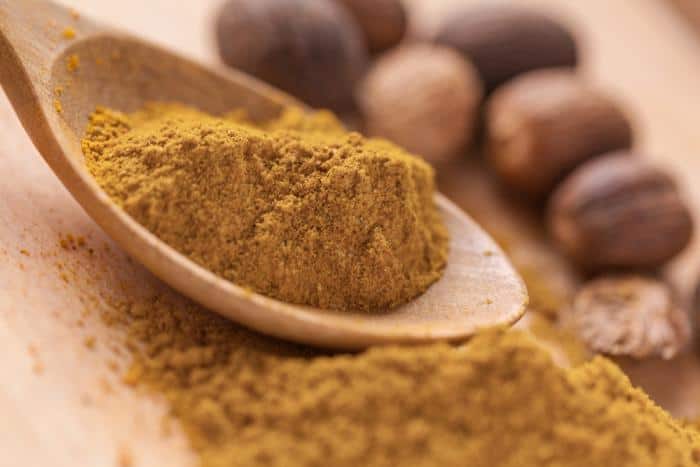Cinnamon which is got from the bark of ‘Cinnamomum verum’ tree grows widely in Sri Lanka, China, India and other regions of South East Asia.
Cinnamon can be used for medicinal purposes and to spice our food.
It is available as dry powder, capsules, tea or liquid extracts.
The two common cinnamon varieties which are used are Cassia and Ceylon Cinnamon.
Cinnamon Bark Oil
Cinnamon bark oil is usually produced by the hydro-distillation method.
In these pieces of twisted shoots and inner bark, twigs are placed in a huge distillation vessel containing water and heated on direct fire.
Two fractions of the oil distill over – one heavier and one lighter than water. Modern steam distillation methods are also used.
Cinnamon bark oil has a sweet, pungent and delicate aroma.
The major chemical in it is cinnamaldehyde. Odor and flavor are got from other minor ingredients. Cinnamon bark oil is exported from
Sri Lanka and the major purchasers are European Union countries – especially France – and the US.
Cinnamon Leaf Oil
To produce cinnamon leaf oil the leaves are first pruned and left to dry for a few days.
After this they are distilled to produce cinnamon leaf oil using water-steam distillation or more traditional methods.
In the traditional method, a huge wooden vessel is fitted on top with a copper head.
This can contain even 200kg of dried cinnamon leaves.
A wood-fired boiler will produce the steam for the distillation.
Cinnamon leaf oil has a stronger odor when compared to bark oil. Its major chemical ingredient is eugenol.
Cinnamon leaf oil is exported from Sri Lanka to Western Europe and the US. Demand for this oil has fallen somewhat due to the easy availability of clove oil that also contains eugenol.
Both oils usually undergo a rectifying process before being exported. This provides a cleaner product with a uniform composition.

Difference Between Cinnamon Bark Oil And Cinnamon Leaf Oil
Uses
Cinnamon bark oil is mostly used as a flavoring agent for meats, pickles, sauces, seasonings for fast foods, tobacco flavors, cola drinks, pharmaceutical, and dental preparations.
Its uses in the perfume industry are limited
Cinnamon bark oil is very strong and should not be used on the skin.
It has powerful antifungal and antibacterial properties and can be used as a diffuser in aroma lamps to cleanse the air.
Inhaling this oil also offers antiseptic benefits and can help clear symptoms of bronchitis, flu, and pleurisy.
It is useful to improve our moods especially when we feel mentally and emotionally fatigued.
Cinnamon bark oil is said to be very effective as a massage oil to improve blood circulation. It is also effective in killing germs.
Cinnamon leaf oil is used as an additive in soaps and insecticides. It is also used to flavor savories and seasonings.
Eugenol in cinnamon leaf oil can be converted to iso-eugenol and used as a flavoring agent.
Cinnamon leaf oil can be diluted and used to treat tooth and gum problems.
It has anti-fungal properties and hence can be used as a diffuser and helps to stimulate the senses.
Used along with ginger, cinnamon leaf oil can provide analgesic benefits.
Cinnamon leaf oil offers very good anti-inflammatory benefits and can be used to make natural health products.
Studies have shown that this oil is an excellent mosquito repellant and offers a natural way to ward off these pests.
Cinnamon bark oil is the preferred oil used in the perfume industry due to its more intense scent.
However, those who make potpourri and body products sometimes go in for the less expensive cinnamon leaf oil due to its lighter and milder fragrance.
Cost
Cinnamon bark oil is more expensive variety when compared to cinnamon leaf oil. This could be because while the entire tree has to be harvested to get the bark, leaves are more easily plucked without damaging the tree.
Precautions
Both cinnamon bark and cinnamon leaf oils could irritate the skin.
Pregnant women are advised against using these oils.
Cinnamon leaf oil could induce childbirth contractions or menstruation.
Avoid leaf oil when using blood thinning medications.

First you say "Cinnamon leaf oil has a stronger odor when compared to bark oil." and then you also say "Cinnamon bark oil is the preferred oil used in the perfume industry due to its more intense scent." That seems contradictory. Which is it?
Also, under uses of Cinnamon bark oil, you say "Cinnamon bark oil is very strong and should not be used on the skin." and then in the next paragraph "Cinnamon bark oil is said to be very effective as a massage oil..." This also seems contradictory. Perhaps you should say "...should not be used undiluted on the skin."